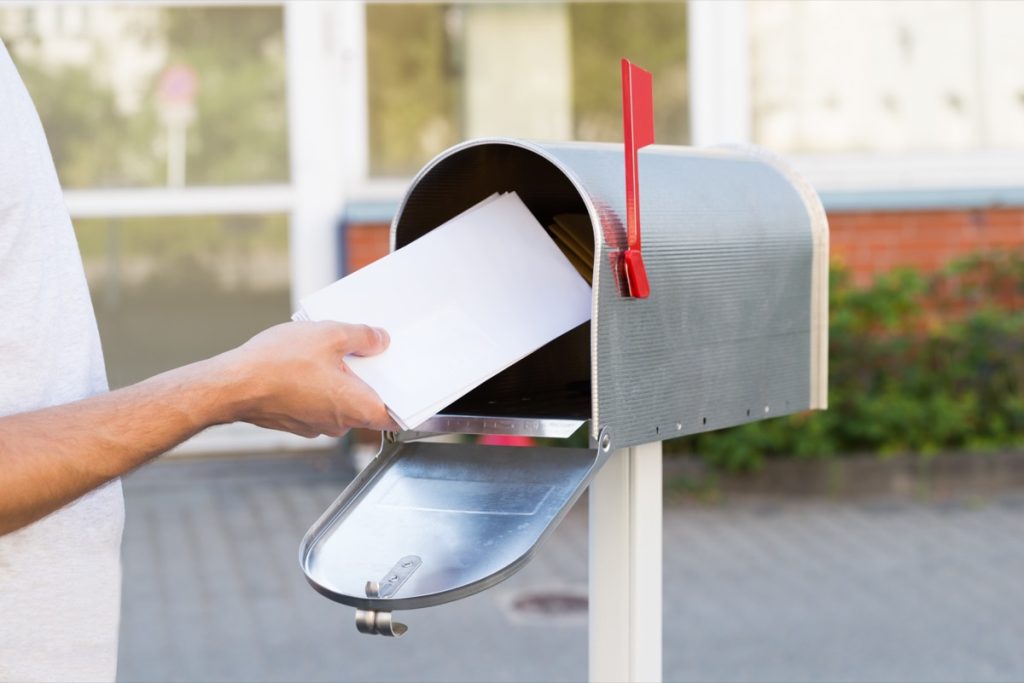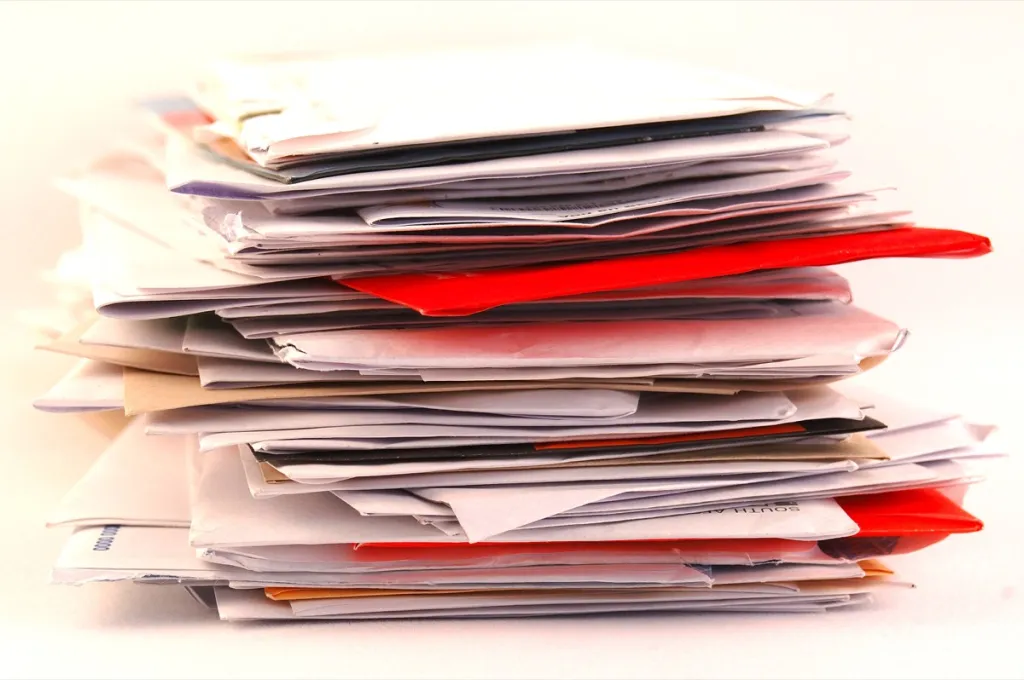5 Biggest Mail Scams Happening Right Now—and How to Stay Safe

Even though we might use it differently on a daily basis than we did just a decade ago, we’re still pretty reliant on the U.S. Postal Service (USPS). From sending off packages to receiving important official documents, the agency plays an essential part in everyday life. Unfortunately, scammers can exploit this reliance to run schemes targeting vulnerable victims. Read on for the biggest mail scams happening right now you should know about.
RELATED: USPS Postal Inspector Reveals How to Mail Checks to Avoid Theft.
1
“Brushing” Scams

Receiving an unexpected care package from a loved one is arguably one of the best surprises that can come from the USPS. But if a box shows up at your front door with no explanation of who it’s from or where it came from, you might be caught up in a “brushing” scam.
According to the U.S. Postal Inspection Service (USPIS), these parcels are filled with items that the recipient never ordered. They also usually don’t include any return address or information on the sender besides possibly a retailer. But while it might be easy to blame this on a logistical error, these packages are usually sent from an international third party who was able to find your address online for the purposes of getting verified buyer status.
“With that stamp of approval, boy, they can do a lot of things,” Bao Vang, vice president of communications at the Better Business Bureau (BBB) of Minnesota and North Dakota, told CBS News. “They can go online and post positive reviews on your behalf, and if those comments start to add up, they can manipulate and skew a ratings-and-review system to gain more customers.”
Unfortunately, this is the type of scam that means your personal information might also be used in another ploy. The USPIS suggests notifying any retailer involved of the problem and closely monitoring your credit card activity following any unexpected boxes.
RELATED: FBI Issues New Warning About the Latest Scams Designed to “Steal Your Money.”
2
Smishing Scams

The tons of text messages we receive on any given day can be a lot to stay on top of as it is. However, you could be the victim of a mail-based scam if you’re not careful.
In this situation, a victim receives a text claiming to be a USPS tracking request or package delivery attempt notification. These “smishing” messages—named for the use of SMS text—also include a link that could be used to steal your personal information as part of an “address confirmation,” or your financial information when requesting a small payment for postage.
And the text doesn’t necessarily have to be from the USPS. “It’s all of the carriers actually because what the scammers are doing is they’re trying to fool you into thinking your package waiting, where your package is delayed, clicking on the link and giving up personal information,” Melanie McGovern, a BBB spokesperson, told Los Angeles ABC affiliate KABC-TV.
The USPIS warns that while the USPS offers text-based delivery tracking, it will never include a link in any of its messages. They warn you never to click any URLs you may receive and not reply to the message, and instead report it to authorities and any companies that might be implicated in the scam.
RELATED: If You Get a Phone Call From One of These 12 Numbers, It’s a Scam.
3
Email-based Scams

Email-based scams have been around pretty much as long as the technology has existed. But while we may all know better than to trust those messages claiming to be a foreign prince trying to share their massive fortunes, crooks have gotten creative using traditional mail as their way to gain your trust.
Similar to how the smishing scam works, intended targets of these email scams typically receive a message in their inbox warning that a failed delivery attempt was made or a small payment is required, according to USPIS. They then link to a website to steal your personal information, passwords, or financial information.
“The details vary, but the scammers are after the same thing: your money and your personal information,” the Federal Trade Commission (FTC) said in a recent alert. “If you click on those links and submit your card information, you’ll end up with nothing—but you’ll find unauthorized charges posted to your account.”
As always, you can usually spot these emails for using poor grammar, spelling mistakes, and creating a sense of urgency. Anyone who receives messages like this should forward them to the USPIS before deleting them.
RELATED: 5 Texts That Are Always Scams, Experts Warn.
4
Identity Theft

Lately, large data breaches have become so common it can make it feel as though digital identity theft is almost an unavoidable fact of life. However, there are still ways scammers use traditional mail to steal your information.
Unlike other USPS-based scams, this one involves not receiving a letter that was meant for you. Crooks will instead steal a piece of incoming or outgoing mail that can give them access to your sensitive personal and financial information, which they can then use to commit fraud and identity theft.
To avoid this, the USPIS suggests dropping off any envelopes with important documents at blue collection boxes as close to their scheduled pickup time as possible—or ideally sending them from a post office location. It’s also best to monitor your credit report and credit card activity so you can pick up on anything suspicious as quickly as possible.
5
Junk Mail

Similar to its digital counterpart, the vast majority of junk mail is one of the minor annoyances that come with using the postal service. But criminals have still been known to use letters to run scams of their own that could wind up being costly.
Like many other text or phone-based scams, junk mail ploys often arrive under the guise of winning a large cash prize, lottery, sweepstakes, or other contest, according to the Office of the Attorney General in California. Many claim the winnings will only become available once intended victims pay a small fee—but will then instead take the money and run.
Unfortunately, the scale of some of these types of scams shows how dangerous they can be. Recently, a Las Vegas man was sentenced to 51 years in prison for “stealing millions of dollars from thousands of elderly victims” in a ploy that ran from 2010 through 2018, local FOX affiliate KVVU reported.
Authorities suggest ignoring any letters that appear too good to be true and reporting any repeat offenders.
RELATED: For more up-to-date information, sign up for our daily newsletter.
- Source: https://www.uspis.gov/news/scam-article/brushing-scam
- Source: https://www.uspis.gov/news/scam-article/smishing-package-tracking-text-scams
- Source: https://www.uspis.gov/news/scam-article/fake-usps-emails
- Source: https://consumer.ftc.gov/articles/what-do-if-youre-billed-things-you-never-got-or-you-get-unordered-products
- Source: https://www.uspis.gov/tips-prevention/identity-theft/
- Source: https://oag.ca.gov/consumers/general/junkmail